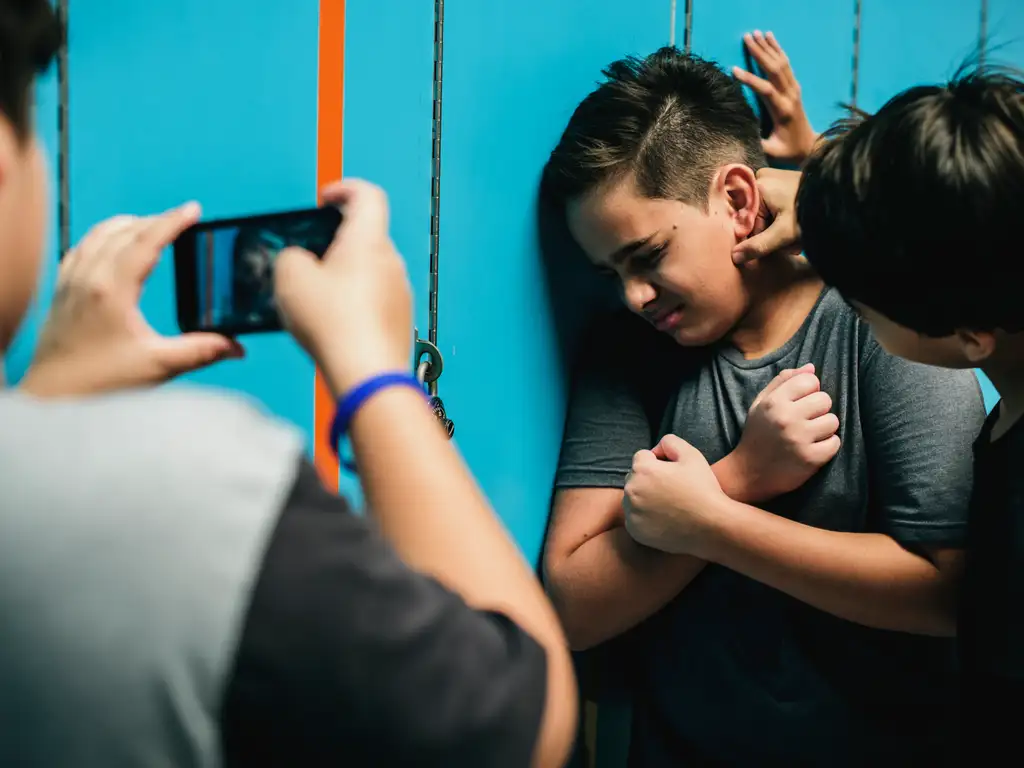Bullying can happen anywhere, at any time, whether it’s in a school building, at home, in the workplace, text messaging, or via online social networks. Bullying behavior, in whatever form it takes, can be devastating and leave lasting consequences. In this article, we will discuss what bullying means and its effects on kids and teens.
Bullying Behaviors Defined
Bullying refers to unwanted, hostile behavior that occurs when there is a power imbalance between the bully and the victim. It’s a pattern of aggressive behavior that occurs repeatedly.
Aggressive behavior that meets the following criteria is considered bullying:
- Perceived power imbalance: Bullies exploit the power they have over their victims, whether that be physical strength, popularity, or knowledge of embarrassing information.
- Repetition: Acts of bullying typically recur or are likely to be repeated.
Physical or verbal abuse, when spreading rumors and stories about someone, or being purposefully left out of a group are all examples of bullying behavior.

Types of Bullying
Both children and adults are vulnerable to a wide range of bullying behaviors, some of which are more overt than others. The following are examples of possible forms that bullying can take.
Physical Bullying
Acts of violence to a person physically such as punching, kicking, pushing, tripping, pinching, or damaging property are all examples of physical bullying. Physical abuse has both immediate and long-term consequences.
Verbal Bullying
Name-calling, insults, taunting, intimidation, racist or homophobic comments about about sexual orientation, and other forms of abusive language all fall under the umbrella and legal definition of verbal bullying. Although verbal bullying may seem harmless initially, it can have serious consequences when it reaches a certain level of severity.
Relational Bullying
Sometimes called “covert” bullying because it occurs behind the victim’s back, social or relational bullying is more difficult to spot. Its goal is to make the target feel ashamed or embarrassed in public.
Cases of social bullying may involve:
- Telling lies and spreading rumors
- Threatening or dismissive body language or expressions
- Using cruel pranks to put someone else down
- Imitating the victim in a mocking way
- Actively encouraging others to isolate a person socially
- Creating negative public opinion of someone
Cyberbullying
Bullying in any form is unacceptable, including cyberbullying, which can take place overtly or covertly through digital devices like computers and cell phones and software like SMS texting, websites, instant messaging, social networking sites, gaming sites, and other online platforms.
Examples of cyberbullying include:
- Emails, texts, posts, photos, and videos that are hurtful or abusive
- Purposefully excluding someone online
- Disgusting rumors or slander
- Posing as the victim or accessing their account

What Causes Bullying Behavior?
Most bullies begin their attacks on others as a way to vent their own frustrations and deal with their own emotional issues. Studies show that both bullies and their victims are more likely to suffer from depression and that a history of neglect or abuse is linked to more antisocial and aggressive behavior.
Mental Health
When children and adolescents have experienced trauma in the past, they may resort to bullying as a coping mechanism, a means of gaining social status, or a means of “protection” by inflicting pain on others before they, too, are harmed.
Recognizing the Vulnerabilities of the Victim
Victims of bullying are generally singled out because they are smaller, weaker, or different in some other way from their peers. Bullies prefer weaker targets since there is less chance of retaliation from them. The reason being, bullies don’t really want to fight, they just need to let off steam. Children of more significant and taller stature are not immune to bullying and teasing because of their appearance, however.
Stress and Pressure From Peers
Even “nice” teenagers can succumb to peer pressure or unhealthy coping mechanisms, turning to bullying when they feel overwhelmed. To put an end to bullying in any context, it’s important to take a careful look at the dynamics at play and the support available to the young people being involved.
Effects of Bullying on Kids and Teens
The impacts of bullying are long-lasting, often even into adulthood, and they vary for each person involved in experiencing bullying affects from any scenario.
Victims
Children who are bullied on a regular basis suffer from both immediate and long-term psychological harm. The negative emotions they experience because of the bullying often follow them into adulthood and develop persistent, even permanent, issues.
Bullying affects habits like eating, sleeping, working, exercising, and engaging in stimulating hobbies — all of which are essential to a happy, healthy lifestyle. Furthermore, it makes it harder to meet new people and maintain existing friendships and romantic relationships.
Emotional Trauma Remains
The common “sticks and stones” thinking is backward when it comes to identifying the most harmful forms of bullying. In reality, emotional trauma remains long after its physical counterpart has healed.
Even if the victim’s body recovers from the wounds, their sense of self may be irreparably damaged from bullying, especially in childhood. The goal of school bullying is to make the victim feel unsafe and ashamed of themselves. Being bullied repeatedly can diminish a person’s sense of worth, competence emotional intelligence, and potential success.
The bully’s victim ends up losing faith in their own abilities as a result. This manifests itself during times of hardship when the victim gives up because they have been conditioned to believe they are too hopeless or weak to pull through. This can have far-reaching effects in areas of life where perseverance and courage are essential, such as the workplace, personal relationships, and other challenging situations.
They have trouble with social skills and making friends, have fewer job prospects, and are more likely to be socially isolated as adults. People who were bullied as children are less likely to make productive decisions and take steps to protect their own well-being.
Bullies
It’s common for bullies to lead miserable lives. Most of the time, their ways of dealing with conflict in the world don’t work well as adults when short tempers and violence are frowned upon. They might struggle to keep a job, maintain friendships, or sustain a relationship with a significant other or family.
Bullies frequently exhibit acquired behavior that was first introduced to them by abusive parents, siblings, or other family members or caretakers. According to the findings of a study published in JAMA Psychiatry, many of these individuals continued to suffer from depression and anxiety into their later years.
Researchers also discovered that children and high school students who were both bullies and victims (bully/victims) had a significantly higher risk of developing mental health problems later in life. Although the study found that children in this group were more likely to have financial difficulties at home than other children, this wasn’t the sole differentiating factor.
A high prevalence of generalized anxiety, panic disorder, and agoraphobia was also found among bully/victims. Bully/victims were found to be at an even higher risk of suicidal behavior (suicidal or self-harming ideation) than pure victims when their lives were tracked into young adulthood.
A shocking 24.8% of youth and bully/victims reported having suicidal thoughts, compared to only 5.7% of young adults who were neither. Panic disorder, depression, and anxiety were also more common in this group. This suggests that being both a bully and a victim of bullying has a mutually destructive element.
Bystanders
As a society, we often fail to recognize the importance of bystanders in bullying situations. In reality, bystanders are a major contributor to bullying dynamics. While bullying can and does occur in secluded settings like bathrooms and empty hallways, it is much more common in crowded public areas. Everywhere in a school environment from the cafeteria to the classroom to the school bus to the playground counts. In fact, bullies often want an audience for their bullying, so having witnesses is crucial.
On the other hand, it is understandable why onlookers opt to do nothing. There are numerous reasons why a bystander would choose not to intervene, such as:
- Worry that the bully will choose them as a new victim
- The idea that it’s “not their problem”
- A sense of shame for “snitching”
- Having already informed teachers who did nothing, so they don’t think intervening will help.
However, inaction should not be confused with passivity. Bystanders are making a conscious decision not to intervene when they choose to ignore, deny, or even enjoy a potentially harmful situation. No matter the circumstances, bystander inaction can have negative consequences for everyone involved. Bystanders are also affected, as they are more prone to engage in risky behaviors such as substance abuse, delinquency, and mental health problems. It’s possible for these behaviors to have far-reaching psychological and public health consequences.
Wrapping Up
What is bullying: physical bullying, verbal bullying, relational bullying, cyber bullying all are based on a perceived power imbalance. CarePlus New Jersey offers services that address the myriad of factors related to victims of bullying, bullying, and youth violence prevention. We work within school districts and may have a counselor within your school building.
When people engage in bullying behavior, it has negative consequences for everyone involved: the victims, the perpetrators, and even the bystanders. Bullying is a social problem, not an individual one. As a society, we must all work together to find solutions to stop bullying.
The 2019 School Crime Supplement to the National Crime Victimization Survey (National Center for Education Statistics and Bureau of Justice) indicates that, nationwide, about 22% of students ages 12–18 experienced bullying.
If you are a loved one are experiencing bullying with someone making threats, sending mean messages, and you are unclear what to do to help your self, friend or family member – reach out to CarePlus New Jersey. Stand up for the victim when you see bullying occur. We have a 24 hour crisis line for Bergen County and have counseling available for you.
If you have a child or adolescent you love with behavioral problems, we can help.
References:
https://jamanetwork.com/journals/jamapsychiatry/fullarticle/1654916
http://www.aaets.org/article204.htm
https://www.ncab.org.au/bullying-advice/bullying-for-parents/types-of-bullying/
https://www.stopbullying.gov/bullying/what-is-bullying
https://paradigmtreatment.com/ptsd-teens-young-adults/bullying-effects/
https://mastersinpsychologyguide.com/articles/psychological-effects-bullying-kids-teens/

CarePlus NJ, INC. is dedicated to excellence in mental healthcare and has a commitment to life-long support needed by individuals and their families to ensure that they achieve their full potential and improve the quality of their lives.

